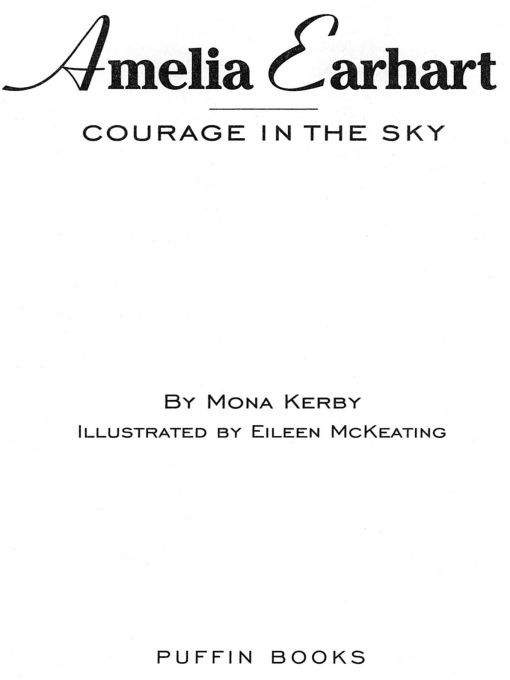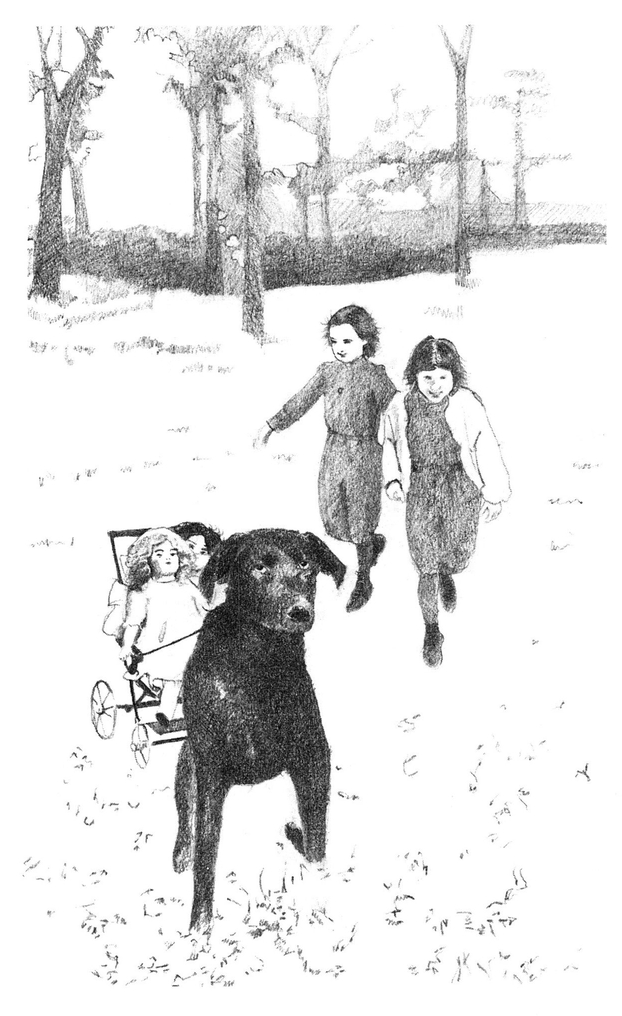Mona Kerby & Eileen McKeating
Read Mona Kerby & Eileen McKeating Online
Authors: Amelia Earhart: Courage in the Sky
Tags: #General, #Biography & Autobiography, #Biography, #Women, #Juvenile Literature, #Juvenile Nonfiction, #Aeronautics; Astronautics & Space Science, #Earhart; Amelia - Juvenile Literature, #Women - Biography, #Science & Nature, #Adventurers & Explorers, #United States, #Air Pilots, #Air Pilots - United States - Biography - Juvenile Literature, #Historical, #Transportation, #Aviation, #Technology, #Earhart; Amelia

Table of Contents
Â
Â
A
melia
E
arhart
melia
E
arhart
COURAGE IN THE SKY
“I know what I want to do and I expect to do it.”
âAmelia Earhart
Â
Â
Praise for the
Women of Our Time®
Series
Women of Our Time®
Series
Â
“Highly regarded authors ... appear in the roster of contributors to âWomen of Our Time.”'â
Parents Magazine
Parents Magazine
Â
“Packs plenty of interest and facts into a brief format for young readers.”âChristian Science Monitor
Â
“Provides insight into diverse personalities ... Accessible, attractive, and balanced ... A welcome resource.”â
The Horn Book
The Horn Book


For Mother and Daddy with love
PUFFIN BOOKS
Published by the Penguin Group
Penguin Books USA Inc., 375 Hudson Street, New York, New York 10014, U.S.A. Penguin Books Ltd, 27 Wrights Lane, London W8 5TZ, England Penguin Books Australia Ltd, Ringwood, Victoria, Australia
Penguin Books Canada Ltd, 10 Alcorn Avenue, Toronto, Ontario, Canada M4V 3B2 Penguin Books (N.Z.) Ltd, 182-190 Wairau Road, Auckland 10, New Zealand
Â
Penguin Books Ltd, Registered Offices: Harmondsworth, Middlesex, England
Â
First published in the United States of America by Viking Penguin,
a division of Penguin Books USA Inc., 1990
Published in Puffin Books, 1992
a division of Penguin Books USA Inc., 1990
Published in Puffin Books, 1992
Â
20 19
Â
Text copyright © Mona Kerby, 1990Illustrations copyright © Eileen McKeating, 1990
All rights reserved
Â
WOMEN OF OUR TIME® is a registered trademark of Viking Penguin,
a division of Penguin Books USA Inc.
a division of Penguin Books USA Inc.
Â
LIBRARY OF CONGRESS CATALOGING-IN-PUBLICATION DATA
Â
Kerby, Mona.
Amelia Earhart: courage in the sky / by Mona Kerby; illustrated
by Eileen McKeating. p. cm.â(Women of our time)
Originally published: New York: Viking, 1990. (Women of our time).
Summary: Follows the life of the pilot who was the first woman to
cross the Atlantic by herself in a plane.
by Eileen McKeating. p. cm.â(Women of our time)
Originally published: New York: Viking, 1990. (Women of our time).
Summary: Follows the life of the pilot who was the first woman to
cross the Atlantic by herself in a plane.
eISBN : 978-1-101-17433-3
1. Earhart, Amelia, 1897â1937âJuvenile literature. 2. Air
pilotsâUnited StatesâBiographyâJuvenile literature.
[1. Earhart, Amelia, 1897-1937. 2. Air pilots.] 1. McKeating,
Eileen, ill. II. Title. III. Series: Women of our time (Puffin Books)
[TL540.E3K47 1992] 629.13'092âdc20 [B] 92-19520
pilotsâUnited StatesâBiographyâJuvenile literature.
[1. Earhart, Amelia, 1897-1937. 2. Air pilots.] 1. McKeating,
Eileen, ill. II. Title. III. Series: Women of our time (Puffin Books)
[TL540.E3K47 1992] 629.13'092âdc20 [B] 92-19520
Â
Set in Garamond #3
Â
1
“It's Just Like Flying!”
The two children stood on the roof of the toolshed and looked down at the slanting track. It stretched eight feet down to the ground. For days they had hammered. At last it was ready. With some help from their uncle, seven-year-old Millie (Amelia) and her five-year-old sister Pidge (Muriel) had built their very own “rolly” coaster.
Millie climbed into the packing crate. She folded her knees into her chest. “Let me go!” she yelled.
The box shot down the wobbly track. Within seconds, the ride was over. The girl and the crate crashed at the bottom.
Millie jumped up. She ignored her torn dress and her hurt lip. She was too excited. “Oh, Pidge,” she said. “It's just like flying!”
Their parents made them tear down the roller coaster. After all, it was dangerous. But maybe Millie remembered the fun of her short “flight.” When she grew up, Amelia Earhart became one of the most famous airplane pilots in the world.
Of course, on July 24, 1897, the night Amelia was born, her family wasn't thinking about airplanes or pilots. In 1897, people didn't fly. There weren't any airplanes. And even if there were, everyone knew that a woman couldn't fly one. That would have been a man's job. In those days, a woman wasn't supposed to have a career. Her place was in the home.
Amelia Mary Earhart was born in Atchison, Kansas, at the home of her grandparents, Judge Alfred Otis and his wife, Amelia. The little girl was named after both of her grandmothers. She was nicknamed Millie by her family.
Amelia's mother, Amy Otis Earhart, wrote later that Amelia was “a real watercolor baby with the bluest of blue eyes, rosy cheeks, and red lips.”
Soon, Amy Earhart and baby Amelia returned to their own home in Kansas City, Kansas. Amelia's father, Edwin Stanton Earhart, worked there as a lawyer for the railroad.
Two years later, in 1899, Amelia's sister, Grace Muriel Earhart, was born. Amelia loved books, animals, and the outdoors. She could read by the time she was four. She kept a book called
Insect Life,
to identify the insects she found. Amelia's favorite books were
Peter Rabbit, Black Beauty,
and all kinds of adventure stories. Almost always, the heroes in those adventures were boys. The girl characters never did anything exciting. Amelia didn't think this was fair.
Insect Life,
to identify the insects she found. Amelia's favorite books were
Peter Rabbit, Black Beauty,
and all kinds of adventure stories. Almost always, the heroes in those adventures were boys. The girl characters never did anything exciting. Amelia didn't think this was fair.
Back then, most parents thought girls should play, dress, and act differently from boys. But Amelia's parents weren't like that. Amelia loved the outdoors, so Mr. Earhart taught her to fish and play ball. And sometimes, just like a boy, Amelia jumped over fences.
It's not easy to jump fences in lacy petticoats and stockings. Mrs. Earhart had bloomers made for her daughters. The bloomers were made out of dark blue flannel, with long sleeves, high collars, and divided skirts that reached to the knees. The two girls still had to wear dark stockings and high-top shoes.
Even though some people said that bloomers weren't proper for little girls, Amelia wore them. They were perfect for walking on stilts, catching toads, and jumping fences.
Amelia didn't like to play with dolls too often. But it was fun to set them in the doll carriage and tie the carriage to her big black dog, James Ferocious. Muriel shook a bone, and James Ferocious took off running. Amelia hollered and chased from behind.
Once when James Ferocious was tied to a rope in the backyard, some boys teased him. James Ferocious barked and jumped until the rope broke. The boys scrambled onto the toolshed.
The barking awoke 6-year-old Amelia from her nap. She ran outside to her dog. “James Ferocious, you naughty dog,” she said, “you've tipped over your water dish again.” She patted her dog and led him inside.
Mrs. Earhart praised Amelia for her bravery, but explained that she could have been hurt. “I wasn't brave,” the little girl replied, “I just didn't have time to be scared.”
“Never run away,” Mr. Earhart often told his daughters. Amelia took her father's words to heart. Big boys and a barking dog didn't frighten her.
In the spring of 1903, when Amelia was five, Mr. Earhart took a train to Washington, D.C. In those days, most people didn't travel very far from home. There weren't any fast planes and cars. Even so, Mr. Earhart went. He had an idea that he thought would make him rich. He had invented a holder that held the signal flags on the backs of trains.

In Washington, Mr. Earhart learned that someone had already invented such a holder. “This news is a terrible blow,” he wrote to his wife.
Later that year, Mrs. Earhart found out exactly what her husband meant. A tax collector came to the Earharts' home.
There's some mistake,
Mrs. Earhart thought. Her husband had paid the taxes. But he hadn't. Mr. Earhart had spent the money for his trip to Washington, D.C.
There's some mistake,
Mrs. Earhart thought. Her husband had paid the taxes. But he hadn't. Mr. Earhart had spent the money for his trip to Washington, D.C.
When Grandfather Otis found out, he was very angry. He said that Edwin Earhart was not a good husband or father. What's more, Grandfather said that Edwin would never make enough money to support his family.
Still, the Judge's disapproval didn't stop Edwin from spending money the very next year. In 1904, rather than saving, Edwin spent $100. Back then, this was a lot of money. He took his family on a week-long vacation to the World's Fair in St. Louis, Missouri.
For the first time in her life, 6-year-old Amelia rode an elephant and a Ferris wheel. Because she was too little to ride the roller coaster, Amelia decided to make one in her own backyard.
Amelia learned more than how to make a roller coaster. She was learning lessons that would last her a lifetime.
If you want to do something,
her father explained,
you must be willing to pay the price.
If you want to do something,
her father explained,
you must be willing to pay the price.
Because her father spent the money, Grandfather Otis disliked him. Grandfather's disapproval was the price Mr. Earhart paid so that his little girls could enjoy themselves.
Amelia watched her father's example and remembered. Years later, when she wanted to fly, she would be willing to pay the price.
2
“Sizz-boom-bah!”
Millie squatted down and held her head close to the porch for a good look. She smiled. Her racer was fat and long and slinky. The leaf and the blade of grass made a perfect carriage and harness. She glanced over at Pidge. Her sister's worm was ready, too. “Go,” Millie shouted, and the worm race was on.
Worm races were just one of the things Amelia dreamed up to do during the summers in Atchison, Kansas. Between 1905 and 1908, Amelia and Muriel lived much of the time with their grandparents. Their parents had moved to Des Moines, Iowa. Mr. Earhart got a good job with the railroad. When he travelled, his wife went with him. The girls remained in Atchison until their mother found a house she thought was right. Besides, Mrs. Earhart thought the schools were better there.
Other books
The Royal Treatment by MaryJanice Davidson
Nina Coombs Pykare by Dangerous Decision
AM02 - The End of the Wasp Season by Denise Mina
The Sword And The Dragon by Mathias, M. R.
Rohn Federbush - Sally Bianco 02 - The Appropriate Way by Rohn Federbush
Terminal Lust by Kali Willows
Fault Line - Retail by Robert Goddard
In Her Eyes by Wesley Banks
Home in Your Arms by Sarah Bale
The Sequin Star by Belinda Murrell